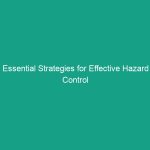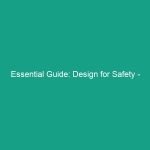Introduction
Health, Safety, and Environment (HSE) concerns are critical in any workplace, regardless of the industry. The primary aim of HSE practices is to ensure that employees operate in a safe environment, free from Hazards that could lead to injury, illness, or even loss of life. A vital concept in this realm is the idea of a near miss. A near miss is an incident that could have resulted in an accident but didn’t, either by chance or through timely intervention. Understanding and addressing near misses is crucial for creating a proactive Safety culture and preventing future incidents.
In this article, we will explore essential strategies to effectively manage near misses, emphasizing their importance in reducing critical Safety risks. By implementing these strategies, organizations can foster a more robust safety culture, enhance employee awareness, and ultimately save lives.
Understanding Near Misses
Before diving into strategies for managing near misses, it’s essential to understand what they entail. A near miss can be defined as an event that does not result in injury, illness, or damage but had the potential to do so. These incidents provide valuable insights into existing safety gaps and highlight areas for improvement.
The Importance of Reporting Near Misses
Reporting near misses is crucial for several reasons. First, it allows organizations to identify patterns and trends in unsafe behaviors or conditions. By analyzing these reports, safety managers can implement changes to mitigate risks. Second, fostering a culture of reporting can enhance employee engagement in safety practices, making them more vigilant and proactive. Third, near miss reporting can improve overall safety performance metrics, which are often scrutinized by regulatory bodies.
Statistics on Near Misses
Research indicates that for every incident resulting in an injury, there are numerous near misses that go unreported. Some studies suggest that the ratio can be as high as 10:1 or even 100:1, depending on the industry. This disparity underscores the need for organizations to prioritize the reporting and analysis of near misses. By doing so, they can proactively address potential Hazards before they escalate into serious incidents.
Regulatory Frameworks Surrounding Near Misses
Various regulatory agencies, including the Occupational Safety and Health Administration (OSHA) in the United States and the Health and Safety Executive (HSE) in the UK, emphasize the importance of reporting and investigating near misses as part of their safety management systems. Organizations must comply with these Regulations to avoid penalties and ensure a safe working environment.
osha Guidelines
OSHA mandates that employers provide a workplace free from recognized hazards that could cause death or serious physical harm. This includes the obligation to report near misses. OSHA encourages employers to develop a systematic approach to identify and address potential hazards, which includes the collection and analysis of near miss incidents.
HSE Regulations
In the UK, the HSE outlines the importance of near miss reporting within its guidelines. Organizations are encouraged to foster a culture where employees feel safe to report near misses without fear of retribution. The HSE also provides resources and Training to help organizations develop effective reporting systems.
Best Practices for Managing Near Misses
Implementing effective strategies to manage near misses can significantly reduce workplace hazards. Here are some Best Practices that organizations should consider:
1. Develop a Reporting System
Creating a user-friendly reporting system is the cornerstone of near miss management. This system should allow employees to report incidents easily and anonymously if desired. Digital platforms, such as mobile applications or online forms, can facilitate this process. The easier it is to report a near miss, the more likely employees will participate in the safety program.
2. Train Employees
Training plays a vital role in cultivating a safety-conscious workforce. Employees should be educated on what constitutes a near miss, the importance of reporting them, and how to use the reporting system effectively. Regular training sessions can reinforce the message and keep safety at the forefront of employees’ minds.
3. Analyze Near Miss Data
Collecting data on near misses is just the beginning. Organizations must analyze this data to identify trends and common factors. This analysis can reveal underlying causes, whether they be environmental, procedural, or behavioral. By understanding these patterns, organizations can implement targeted interventions to reduce the likelihood of future incidents.
4. Communicate Findings
Once data has been analyzed, it’s essential to communicate findings to all employees. Sharing insights on near miss incidents can help raise awareness and promote a culture of safety. Management should highlight both the incidents and the corrective actions taken to demonstrate a commitment to improving Workplace Safety.
5. Encourage a Safety Culture
Developing a strong safety culture within an organization is critical for effective near miss management. Leaders should model safe behaviors and encourage open dialogue about safety concerns. Recognizing and rewarding employees who report near misses can also reinforce the importance of proactive safety practices.
Case Studies: Successful Near Miss Management
Real-world examples can provide valuable lessons on the effective management of near misses. Here are a couple of case studies illustrating successful strategies:
Case Study 1: Manufacturing Facility
A manufacturing facility experienced a high number of near misses related to machinery Operation. To address this issue, the management implemented a comprehensive reporting system and conducted training sessions on machine safety. Over the course of a year, the facility collected data on near misses, which they analyzed to identify common factors. As a result, they introduced new safety protocols and improved machine guarding. This proactive approach led to a 30% reduction in near misses and enhanced overall safety culture.
Case Study 2: Construction Site
A construction company recognized that near misses were prevalent during high-risk tasks, such as scaffolding and electrical work. They established a near miss reporting app that allowed workers to report incidents immediately. The management held monthly safety meetings to review near misses and brainstorm preventative measures. Consequently, the company saw a significant decline in serious accidents, demonstrating that addressing near misses directly impacts overall safety performance.
Challenges in Near Miss Reporting
Despite the clear Benefits of near miss reporting, organizations often face challenges in implementation. Some common obstacles include:
1. Employee Reluctance
Employees may be hesitant to report near misses due to fears of blame or retaliation. It is crucial for management to cultivate an environment where employees feel safe to speak up. Emphasizing that near miss reporting is a learning opportunity rather than a punitive measure can help alleviate these concerns.
2. Lack of Awareness
Some employees may not fully understand what constitutes a near miss or the importance of reporting it. Providing comprehensive training and ongoing education can bridge this knowledge gap and encourage more robust participation in safety programs.
3. Insufficient Resources
Organizations may struggle to allocate sufficient resources for effective near miss management. Developing a near miss program requires investment in training, reporting systems, and data analysis. However, the long-term benefits of reducing accidents and improving safety culture far outweigh the initial costs.
Future Trends in Near Miss Management
As organizations continue to prioritize safety, several trends are emerging in near miss management:
1. Increased Use of Technology
Technology is playing an increasingly vital role in safety management. Mobile apps and digital reporting systems are becoming standard tools for collecting and analyzing near miss incidents. Additionally, wearable technology can monitor employee behavior and environmental conditions, providing real-time data to prevent potential hazards.
2. Data-Driven Decision Making
Organizations are increasingly relying on data analytics to inform their Safety Strategies. By leveraging data collected from near miss reports, companies can make informed decisions about where to allocate resources and how to implement targeted Safety Measures. This data-driven approach can lead to more effective safety interventions and improved outcomes.
3. Emphasis on Behavioral Safety
There is a growing recognition that many workplace incidents are the result of unsafe behaviors rather than environmental factors. As a result, organizations are focusing on behavioral safety training to address the human element of safety. By understanding the psychology behind unsafe behaviors, organizations can develop strategies to promote safer practices among employees.
Conclusion
In conclusion, effective management of near misses is a crucial aspect of health, safety, and environmental practices. By understanding what constitutes a near miss and implementing Best Practices for reporting and analysis, organizations can significantly reduce critical safety risks. The regulatory frameworks surrounding near misses emphasize their importance, and successful case studies demonstrate the benefits of proactive near miss management.
As we move forward, embracing technology and data-driven approaches will be vital in shaping the future of near miss management. By prioritizing safety and fostering a culture of reporting, organizations can protect their most valuable asset—their employees. We encourage all organizations to take the necessary steps today to implement these strategies and make safety a top priority.


